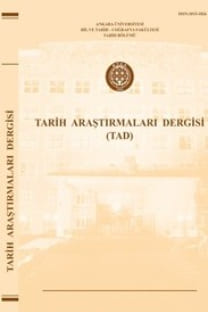Yeni Asur metinlerinde geçen “Masennu” unvanlı bazı memurlar
Asur tarihinin Yeni Asur Dönemi olarak adlandırılan bölümünde başa geçen kralların ülkeyi, gelişmiş bir bürokrasi anlayışı ile yönettikleri anlaşılmaktadır. Merkezde ve en üstte kralın olduğu bu yönetim anlayışında ülke eyaletlere ayrılmıştı. Eyaletlere merkezdeki sarayların birer küçük örneği yapılmış, başlarına da merkezden atanan yönetici ve memurlar yerleştirilmiştir. Bunlardan birisi de, çivi yazılı metinlerde Sumerce LÚAGRIG, LÚ.IGI.DUB, Akadca “masennu” veya “abarakku” olarak geçen ve çoğunlukla “hazineci” veya sadece “yüksek dereceli memur” şeklinde tercüme edilen memur sınıfıdır
Anahtar Kelimeler:
Yeni Asur, Eyalet Sistemi, LÚAGRIG, LÚ.IGI.DUB, masennu, abarakku
Some Officials of “Masennu” Titles in the Neo-Assyrian Documents
It is understood that Assyrian kings administered the country via improved bureaucracy mentality in the Neo-Assyrian Period. Kings were in the center and top in this mentality and also the country was divided as provincies. Provincies included a palace like the great center palace which were administered by governers or officials. One of the high officials was LÚAGRIG, LÚ.IGI.DUB as Sumerian, “masennu” or “abarakku” as Akkadian and generally translated as a “treasurer” or only “high official”
Keywords:
Neo-Assyrian, Province System, LÙAGRIG, LÚ.IGI.DUB, masennu, abarakku,
___
- BARJAMOVİC, Gojko, “Pride, Pomp and Circumstance: Palace, Court and Household in Assyria 879 – 612 BCE”, in J. Duindam, T. Artan & M. Kunt (eds.), Royal Courts in Dynastic States and Empires: A Global Perspective, Rulers & Elites: Comparative Studies in Governance Vol. I,Leiden, Brill, 2011, pp.27-61.
- BEDFORD, Peter, Empire and Exploitation: The Neo-Assyrian Empire, Social Science History Institute, Standford University, May 21-22, 2001.
- CAD A,Vol. I:The Assyrian Dictionary of the Oriental Institute of the University of Chicaqo, A.L.Oppenheim,E.Reiner,Vol.I,4.BaskıChicaqo 1998, pp.32-35. Board: I.J.Gelb, B.Landsberger
- CAD M,Vol. X: The Assyrian Dictionary of the Oriental Institute of the University of I.J.Gelb,A.L.Oppenheim,E.Reiner,Vol.10, 3.Baskı, Chicaqo 2004,pp.363-364. Editorial Board:M.Civil
- CAH III/2: GRAYSON, A.Kırk, “Assyrian Civilization”, (ed.) John Boardman, İ.E.S.Edwards, N.G.L. Hammond, E.Sollberger, C.B.F.Walker, Cambridge Ancient History III/2, The Cambridge University Press, Second Edition, UK 2008, pp.194-229.
- CANCİK-KİRSCHBAUM, Eva, Asurlular (Tarih, Toplum, Kültür), Çev. Aslı Yarbaş, İzmir, İlya İzmir Yayınevi, 2004.
- ÇAMBEL, Halet, Karatepe-Arslantaş: The Inscriptions, Corpus of Hieroglyphic Luwian Inscriptions, Vol.II, Untersuchungen Zur Indogermanischen Sprach- und Kulturwissen schaft.Nf., Berlin 1998.
- FOSTER, Benjamin, “A New Look at the Sumerian Temple State”, JESHO, XXIV/3, 1981, pp.225-241.
- GRAYSON, A.Kırk, “Assyrian Officials and Power in the Ninth and Eight Centuries”, State Archives of Assyria Bulletin, VII/1, 1993, pp.19-52.
- HECKER, Bernice Varjick, The Biradical Origin of Semitic Roots, PhD Dissertation, The University of Texas at Austin, May 2007.
- HENSHAW, Richard A., “The Office of Šaknu in Neo-Assyrian Times I”, JAOS, 87/4, Oct.-Dec.1967, pp.517-525.
- -----------------------------., “The Office of Šaknu in Neo-Assyrian Times II”, JAOS, 88/3, Jul.-Sep.1968, pp.461-483.
- HESS R.-TSUMURA, D.T., Ancient Near Eastern, Literary and Linguistic Approaches to Genesis I-II, Vol.4, USA 1994.
- JONES, F.N., The Chronology of the Old Testament, USA 2005.
- KÖROĞLU, Kemalettin, Eski Mezopotamya Tarihi, İletişim Yay.,İstanbul 2006.
- MATTİLA, Raija, The King’s Magnates, A Study of the Highest Officials of the Neo-Assyrian Empire, State Archives of Assyrian Studies (SAAS) XI, Neo- Assyrian Text Corpus Project, 1999.
- MCİNTOSH, Jane R., Ancient Mesopotamia: New Perspectives, California 2005.
- MILLARD, Alan, “The Eponyms of the Assyrian Empire 910-612 BC”, State Archives of Assyria Studies, Vol.II, Helsinki 1994.
- PARPOLA, Simo, Letters from Assyrian Scholars to the Kings Esarhaddon and Ashurbanipal, Part II: Commentary and Appendices, AOAT Bd.5/2,Verlag, Neukirchen-Vluyn 1983.
- PARPOLA, Simo-Porter, M., The Helsinki Atlas of the Near East in the Neo- Assyrian Period, Helsinki 2001.
- POSTGATE, J.N., “Assyria: the Home Provinces”, Neo-Assyrian Geography, (ed.) Mario Liverani, Università di Roma “La Sapienza”,Dipartimento di Scienze storiche, archeologiche e antropologiche dell’ Antichità, Quaderni di Geografia Storica 5, Roma 1995.
- REYHAN, Esma, “Hititler’de Devlet Gelirleri, Depolama ve Yeniden Dağıtım”, Akademik Bakış, C.2, S.4, Ankara 2009,s.157-174.
- SAA 01: PARPOLA, Simo, The Correspondence of Sargon II, Part I: Letters from Assyria and the West, State Archives of Assyria, Volume I, Helsinki 1987.
- SAA 05: LANFRANCHİ, G. B. and PARPOLA, S., The Correspondence of Sargon II, Part II: Letters from the Northern and Northeastern Provinces, State Archives of Assyria, Helsinki 1990.
- SAA 06: KWASMAN , T. and PARPOLA, S., Legal Transactions of the Royal Court of Nineveh, Part I: Tiglath-Pileser III through Esarhaddon, State Archives of Assyria, Helsinki 1991.
- SAA 14: MATTİLA, R., Legal Transactions of the Royal Court of Nineveh, Part II: Assurbanipal Through Sin-šarru-iškun, State Archives of Assyria, Helsinki 2002.
- SAA 15: FUCHS, A. and PARPOLA, S., The Correspondence of Sargon II, Part III: Letters from Babylonia and the Eastern Provinces, State Archives of Assyria, Helsinki 2001.
- SAA 16: LUUKKO, M. and BUYLAERE, G. Van, The Political Correspondence of Esarhaddon, State Archives of Assyria, Helsinki 2002.
- SİNGER, Itamar, “The AGRIG in the Hittite Texts”, Anatolian Studies, Vol.34, London 1984, s.97-127.
- WHITTAKER, Gordon, The Case of Euphratic, Bulletin of the Georgian National Academy of Sciences, Vol.2, No.3, 2008, pp.156-168.
- ISSN: 1015-1826
- Yayın Aralığı: Yılda 2 Sayı
- Başlangıç: 1963
- Yayıncı: Levent KAYAPINAR
Sayıdaki Diğer Makaleler
İbn Battūta’nın Suriye ve Arabistan’a 726/1326’da yaptığı seyahate ilişkin bir inceleme
Yeni Asur metinlerinde geçen “Masennu” unvanlı bazı memurlar
Türk Devleti’nde akıl: Kutadgu Bilig ve Babürnâme
Altan Çetin, Haldunnâme (İbn Haldun’un izinde metodoloji ve tarihi yeniden düşünmek)
Kuzey Savaşları sırasında Rusya’nın Karadeniz’e yönelik faaliyetleri
Cevat Hakkı Tarım, Kırşehir tarihi üzerine araştırmalar I
Alābum’un oğlu Kuliya’ya ait beş tablet
Tahrir defterlerine göre Anadolu’da Kalenderîler ve Haydarîler
